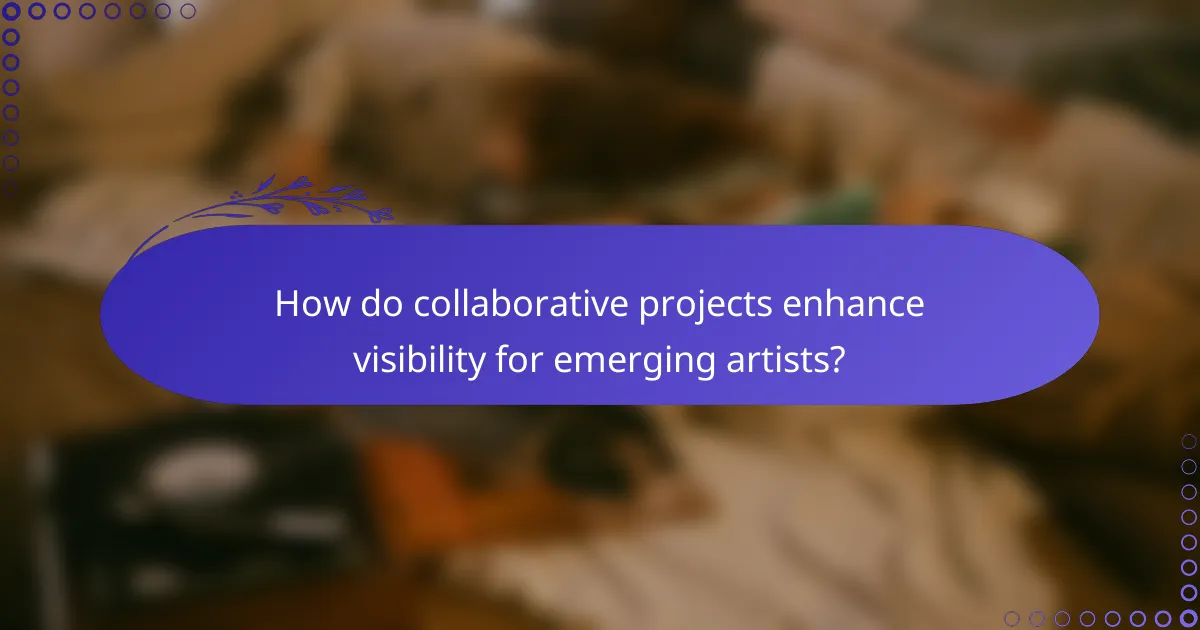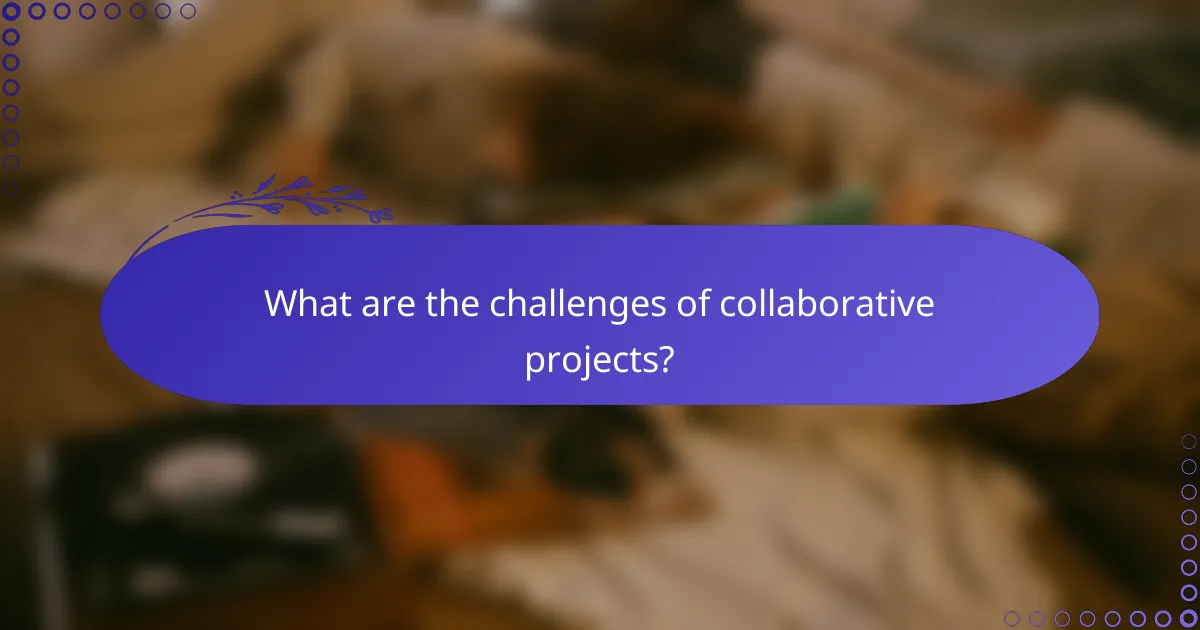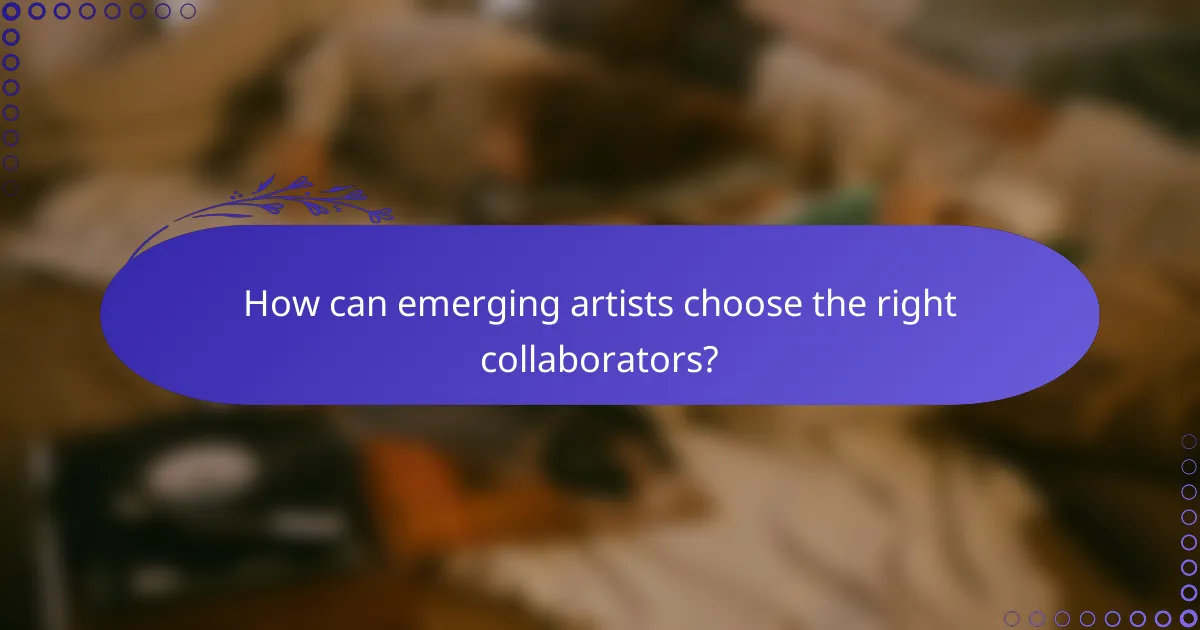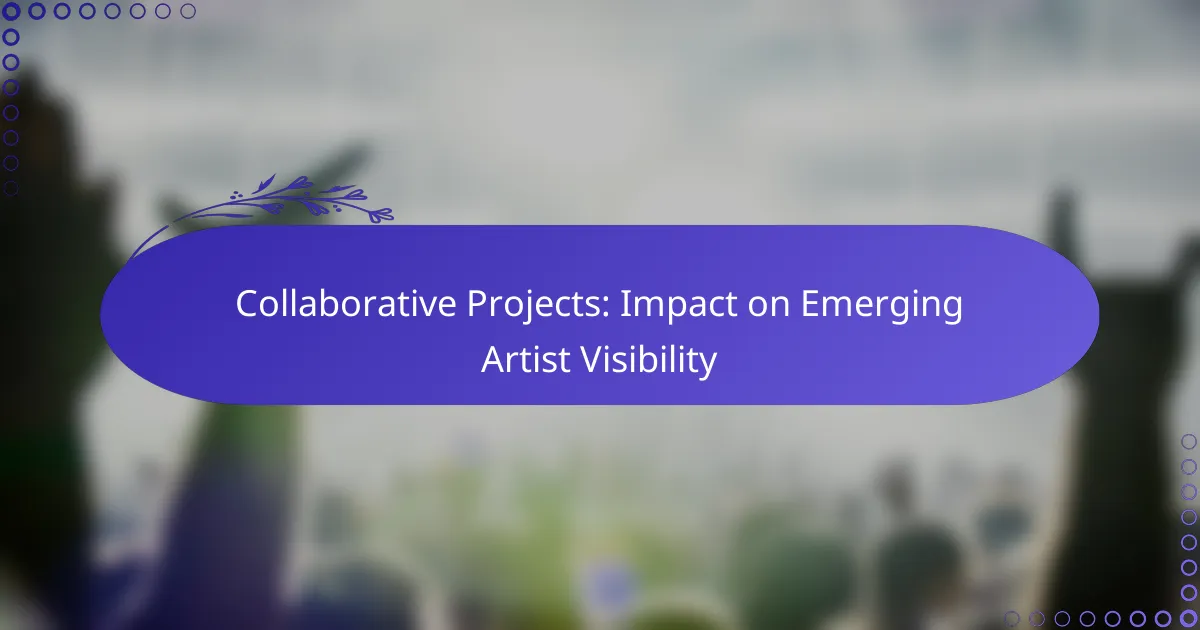Collaborative projects play a crucial role in increasing visibility for emerging artists by providing access to wider audiences and shared resources. Through art exhibitions, music collaborations, and online platforms, these partnerships enable artists to showcase their work and connect with potential fans in ways that individual efforts often cannot achieve.

How do collaborative projects enhance visibility for emerging artists?
Collaborative projects significantly enhance visibility for emerging artists by allowing them to tap into broader audiences and leverage shared resources. These partnerships create opportunities for exposure that individual efforts may not achieve alone.
Increased audience reach
Collaborative projects enable emerging artists to reach new audiences by combining their fan bases. When artists work together, they introduce each other to their respective followers, which can lead to increased engagement and new opportunities.
For example, a visual artist collaborating with a musician can attract both art enthusiasts and music fans, potentially doubling their audience. This cross-pollination is particularly effective in social media campaigns, where shares and tags can amplify visibility rapidly.
Access to established networks
Working with established artists or brands provides emerging artists access to valuable networks that can facilitate further opportunities. These connections often include industry professionals, galleries, and event organizers who may not be accessible otherwise.
For instance, a young filmmaker collaborating with a well-known actor can gain introductions to producers and distributors, enhancing their chances of securing funding or distribution deals. This network access can be a game-changer for an artist’s career trajectory.
Shared marketing resources
Collaborative projects allow artists to pool their marketing resources, which can lead to more effective promotional strategies. By sharing costs and efforts, artists can create higher-quality marketing materials and campaigns than they might manage individually.
For example, two artists can co-host an exhibition, sharing the costs of venue rental, promotional materials, and advertisements. This not only reduces financial burden but also creates a more significant impact through a combined marketing push, leading to higher attendance and visibility.

What types of collaborative projects are most effective?
Collaborative projects that effectively enhance the visibility of emerging artists typically include art exhibitions, music collaborations, and online platforms. Each of these avenues allows artists to showcase their work, connect with audiences, and gain exposure in unique ways.
Art exhibitions and installations
Art exhibitions and installations provide a physical space for emerging artists to display their work alongside established names. These events often attract a diverse audience, including collectors, critics, and the general public, enhancing visibility significantly.
Consider partnering with local galleries or community centers to host joint exhibitions. This can reduce costs and increase foot traffic, making it easier for new artists to gain recognition.
Music collaborations
Music collaborations allow emerging musicians to work with more established artists, which can lead to increased exposure and credibility. By featuring on tracks or performing together, new artists can tap into the established artist’s fan base.
When pursuing collaborations, focus on artists whose style complements yours. This synergy can create a more authentic experience for listeners and enhance both artists’ visibility in the music scene.
Online platforms and digital showcases
Online platforms and digital showcases have become essential for emerging artists, especially in a globalized market. Websites, social media, and streaming services enable artists to share their work widely without the constraints of physical space.
Utilize platforms like Instagram, Bandcamp, or Behance to showcase your work. Regularly engaging with followers and participating in online events can significantly boost visibility and foster a supportive community around your art.

Which platforms support collaborative projects for artists?
Several platforms facilitate collaborative projects for artists, enhancing their visibility and reach. These platforms cater to different artistic disciplines, allowing creators to connect, share, and showcase their work collaboratively.
Instagram for visual artists
Instagram serves as a powerful tool for visual artists to collaborate and gain exposure. Artists can create joint posts, stories, or even live sessions, allowing them to showcase their combined talents to a wider audience.
Using features like Instagram Reels or IGTV can further enhance collaboration, as artists can create engaging video content together. Regularly tagging each other and using relevant hashtags can significantly increase visibility and engagement.
SoundCloud for musicians
SoundCloud is an excellent platform for musicians to collaborate on tracks and share their work with a global audience. Artists can upload collaborative songs, remixes, or playlists, which can attract listeners from different genres and backgrounds.
Utilizing SoundCloud’s comment feature allows artists to receive feedback directly from listeners, fostering community interaction. Collaborating with artists who have a similar or larger following can help in reaching new audiences effectively.
Behance for designers
Behance is tailored for designers to showcase collaborative projects and portfolios. It allows artists to present their work in a visually appealing manner, making it easy for potential clients and collaborators to discover their talents.
Designers can create project pages that highlight their collaborative efforts, including detailed descriptions and process images. Engaging with the Behance community through comments and appreciations can also enhance visibility and networking opportunities.

What are the challenges of collaborative projects?
Collaborative projects often face several challenges that can hinder their success. Key issues include creative differences, resource allocation problems, and time management conflicts, all of which can impact the overall effectiveness and visibility of emerging artists involved.
Creative differences
Creative differences can arise when artists have varying visions, styles, or approaches to a project. These differences can lead to conflicts that may stall progress or dilute the original intent of the collaboration. To navigate this, it’s essential to establish a clear creative direction early on and encourage open communication among all participants.
For instance, if one artist prefers a minimalist aesthetic while another favors a more elaborate design, discussing these preferences upfront can help align their goals. Regular check-ins can also ensure that everyone remains on the same page throughout the project.
Resource allocation issues
Resource allocation issues often occur when collaborators have different levels of access to materials, funding, or tools. This disparity can create tension and lead to feelings of inequality among team members. To mitigate this, it’s crucial to outline resource needs and contributions from the outset, ensuring that all parties understand their roles and responsibilities.
For example, if one artist is responsible for sourcing materials while another handles marketing, clearly defining these tasks can prevent misunderstandings. Utilizing shared budgets or pooling resources can also foster a sense of teamwork and fairness.
Time management conflicts
Time management conflicts can derail collaborative projects when team members have differing schedules or priorities. These conflicts can result in missed deadlines and frustration among collaborators. Establishing a realistic timeline with agreed-upon milestones can help keep everyone accountable and focused.
It’s beneficial to use project management tools or shared calendars to track progress and deadlines. Regular updates can help identify potential delays early, allowing the team to adjust their plans accordingly and maintain momentum throughout the project.

How can emerging artists choose the right collaborators?
Emerging artists can choose the right collaborators by assessing artistic compatibility, evaluating audience overlap, and understanding mutual goals. These factors ensure that partnerships enhance visibility and resonate with both artists’ audiences.
Assessing artistic compatibility
Artistic compatibility involves aligning styles, mediums, and creative visions. Emerging artists should review potential collaborators’ portfolios to identify shared themes or techniques that can lead to a cohesive project.
Consider arranging a trial collaboration, such as a joint artwork or performance, to gauge how well both artists work together. This can reveal whether their creative processes complement each other.
Evaluating audience overlap
Audience overlap is crucial for maximizing visibility. Artists should analyze their current followers and those of potential collaborators to determine how many fans might be interested in both parties’ work.
Tools like social media analytics can help identify common demographics. A partnership with a collaborator who has a similar or slightly larger audience can create opportunities for cross-promotion and engagement.
Understanding mutual goals
Establishing mutual goals ensures that both artists benefit from the collaboration. Discussing objectives such as exposure, financial gain, or artistic growth can clarify expectations and enhance the partnership’s effectiveness.
It’s helpful to create a simple agreement outlining each artist’s contributions and desired outcomes. This can prevent misunderstandings and keep the project focused on shared aspirations.

What metrics measure the success of collaborative projects?
Success in collaborative projects can be evaluated through various metrics that reflect visibility and engagement. Key indicators include audience reach, participant feedback, and the impact on individual artist profiles.
Audience Reach
Audience reach measures how many people engage with the collaborative project. This can be tracked through social media impressions, website traffic, and attendance at events. For example, a project that garners thousands of views online or attracts a significant number of attendees at a gallery opening demonstrates strong audience reach.
To effectively measure this, consider using analytics tools to track engagement metrics across different platforms. Aim for a clear understanding of where your audience is coming from and which channels are most effective.
Participant Feedback
Participant feedback is crucial for assessing the qualitative success of collaborative projects. Surveys and interviews can provide insights into how artists feel about their involvement and the project’s overall impact on their visibility. Positive feedback often indicates that the project has successfully enhanced participants’ profiles.
Collecting feedback should be a structured process, ideally using standardized questions to allow for easy comparison. Look for trends in responses that highlight areas of strength and opportunities for improvement.
Impact on Individual Artist Profiles
The impact on individual artist profiles can be gauged by examining changes in their visibility and opportunities following the project. Metrics such as increased social media followers, invitations to future collaborations, or sales of artwork can serve as indicators of success.
To assess this impact, track artists’ metrics before and after the project. A notable increase in engagement or opportunities can signify that the collaborative effort has effectively raised their profile in the art community.
